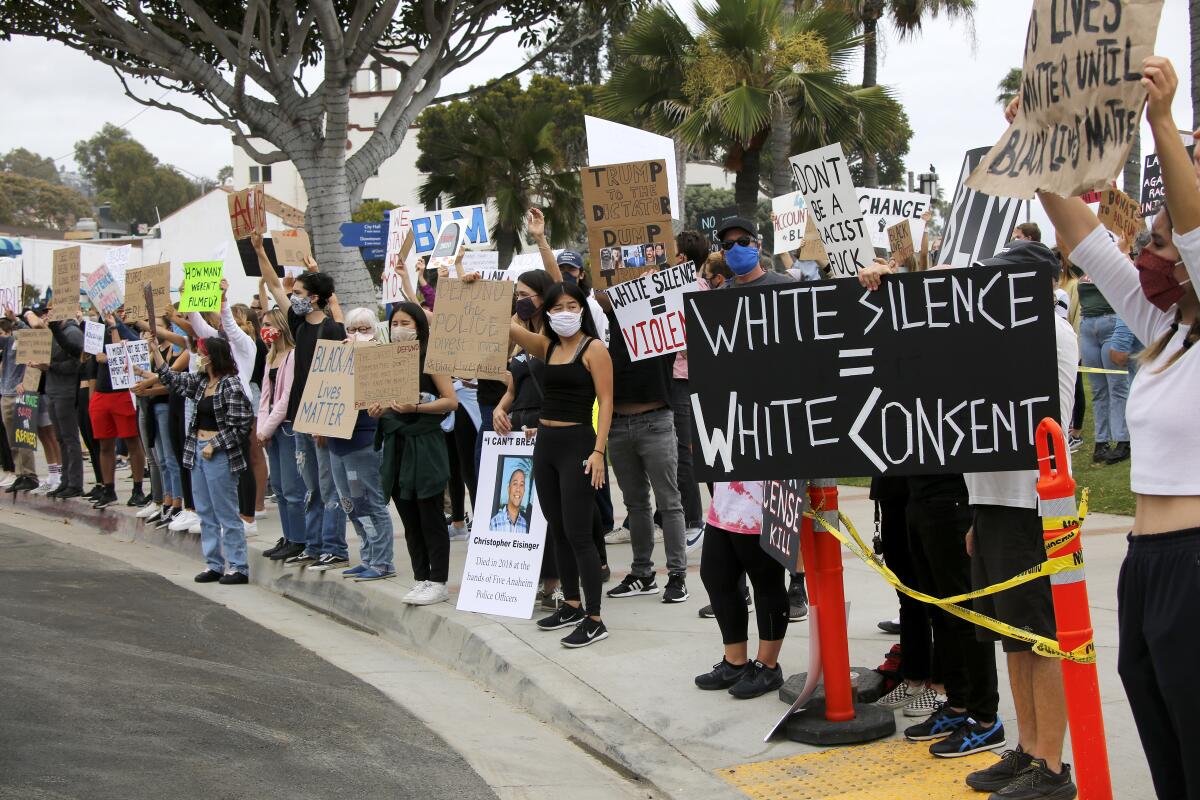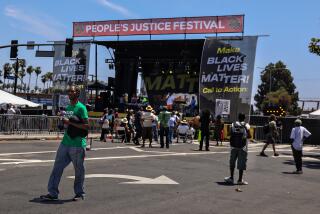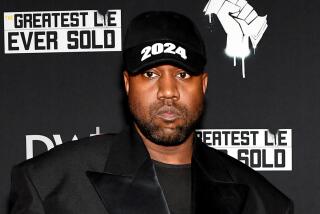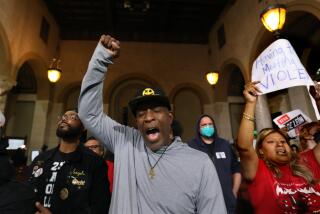White people have gentrified Black Lives Matter. It’s a problem

WASHINGTON — Black Lives Matter was once shunned by the white establishment. But now, it’s chic. And that’s a problem.
BLM banners fly from homes in Silver Lake. BLM posters are taped to the windows of Portland coffee shops. BLM hashtags fill users’ bios on Twitter and Tinder.
For the record:
12:44 p.m. Oct. 1, 2020An earlier version of this article contained a reference to a protester who sat naked in front of a line of police officers in Portland in July, and incorrectly described her as white. The protester says she is a non-Black person of color.
Institutions including Uber, Airbnb and the National Football League have embraced Black Lives Matter. (Yes, the same NFL that shunned Colin Kaepernick four years ago for kneeling in protest of police brutality now issues calls to “end racism” in their endzones.)
This jolt of white solidarity is not imaginary. According to a June poll from Monmouth University, 49% of white Americans now say police are more likely to use excessive force against a Black culprit. In 2016, that figure was 25%. But will it last?
White people have been involved in Black liberation efforts for centuries, from abolition in the 19th century to civil rights in the 20th, according to Hasan Kwame Jeffries, a history professor at Ohio State.
Some white supporters bolstered the original Black Lives Matter movement, which emerged in response to the police killing of Michael Brown in Ferguson, Mo., in August 2014. And in this second big wave of BLM protests that began in May after the police killing of George Floyd in Minneapolis, an unprecedented number of white people flooded the streets.
Young people like me (I’m 25) were the largest age cohort among the protesters. One reason young people protested is that they had been cooped up in their homes due to the global pandemic, said Douglas McAdam, a sociologist at Stanford who studies social movements. He told me that the dire economy, coupled with disdain for the current president, is also a factor in a large number of young people in the streets.
In other words, it can be hard to disaggregate young people’s rage about the loss of life, hope, jobs and opportunities from their righteous solidarity with Black protesters.
But Jeffries told me that, in broad terms, there is a distinction between the motivations of white and Black protesters.
Historically, when Black people protest, they are responding to intolerable and immediate injustice — say, the water crisis in Flint. In contrast, Jeffries said, white Americans tend to protest over more abstract goals — like the Occupy Wall Street protests against economic inequality or the melting of Arctic glaciers — and are driven by the “fierce urgency of the future.”
“What you’re willing to sacrifice, demand and compromise is going to be different,” Jeffries said. “There is a shared sense of the problem but your immediate objective is fundamentally different.”
This is certainly true for AJ Lovelace. The 28-year old activist filmmaker felt the marches over the summer started off coherent and then devolved into being performative.
“It was obvious to me that people were out there to say they were out there,” Lovelace said. “White girls would agitate the police and then cry when they responded. This isn’t how a protest works.”
“Saying Black Lives Matter is about the present,” Lovelace said. “If we are alive and breathing now, we are entitled to having a future. And I feel like white people get caught up in the game of politics and they lose the focus that this is not just about that. What it is about is changing a racist and oppressive system so there can be real measurable equality and equity,” he said.
“It’s bigger than one presidential candidate,” he added.
As a Black woman, I agree. It’s hard for white people to grasp that Black people have suffered from systemic racism under every president, including Barack Obama. Black America knows this struggle began long before Trump and will persist once he’s gone.
William Sturkey, a historian at the University of North Carolina at Chapel Hill, said that when Black liberation movements emerge, there always “comes a point when white allies realize the gravity of the movement and want to make sure they are on the right side of history.”
“Their presence in the civil rights movement did help shine more of a light on protests but it overshadowed the courage of the original Black activists,” he said.
White co-optation can overshadow those involved in grassroots efforts, and it creates the illusion that “everyone was part of this movement the whole time,” he said. After the dust settled in the 1970s and public opinion shifted, everyone claimed to have been a civil rights activist.
Anti-racist author and lecturer Tim Wise said he is “cautiously optimistic” about the onslaught of white faces in crowds but also “nervous about what happens when people who really up until May weren’t particularly engaged in this issue are all of a sudden ‘ready for the revolution.’”
Wise said that while protests can be cathartic, “95% of what needs to happen is not in the streets.”
That’s true. Most of what needs to change happens in a civic setting often void of TV cameras. It’s going to take drastic changes in policy and laws. It will also require everyone’s attention.
Jeffries told me that if history shows one thing to be true, it’s that white attention and sympathy for Black social justice is fleeting. It wanes when cameras disappear.
I fear that may be happening now.
According to a June poll, 45% of white people surveyed found racism to be a “big problem.” In the latest poll, that number had already fallen to 38%.
I suppose I’m not too surprised ... because ... white people.
More to Read
A cure for the common opinion
Get thought-provoking perspectives with our weekly newsletter.
You may occasionally receive promotional content from the Los Angeles Times.











